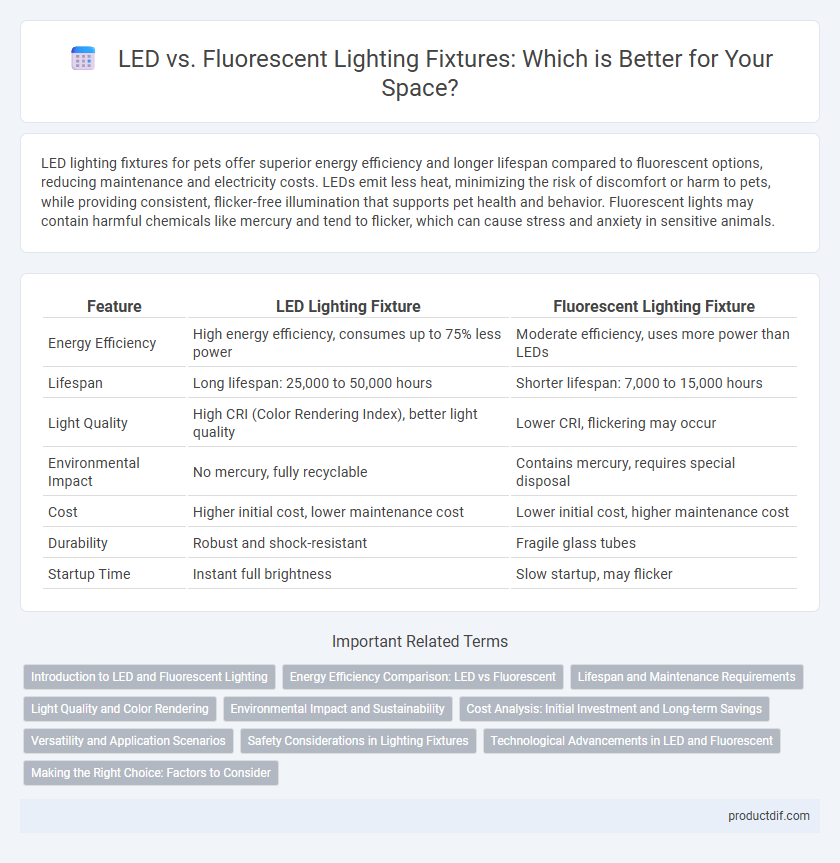LED lighting fixtures for pets offer superior energy efficiency and longer lifespan compared to fluorescent options, reducing maintenance and electricity costs. LEDs emit less heat, minimizing the risk of discomfort or harm to pets, while providing consistent, flicker-free illumination that supports pet health and behavior. Fluorescent lights may contain harmful chemicals like mercury and tend to flicker, which can cause stress and anxiety in sensitive animals.
Table of Comparison
| Feature | LED Lighting Fixture | Fluorescent Lighting Fixture |
|---|---|---|
| Energy Efficiency | High energy efficiency, consumes up to 75% less power | Moderate efficiency, uses more power than LEDs |
| Lifespan | Long lifespan: 25,000 to 50,000 hours | Shorter lifespan: 7,000 to 15,000 hours |
| Light Quality | High CRI (Color Rendering Index), better light quality | Lower CRI, flickering may occur |
| Environmental Impact | No mercury, fully recyclable | Contains mercury, requires special disposal |
| Cost | Higher initial cost, lower maintenance cost | Lower initial cost, higher maintenance cost |
| Durability | Robust and shock-resistant | Fragile glass tubes |
| Startup Time | Instant full brightness | Slow startup, may flicker |
Introduction to LED and Fluorescent Lighting
LED lighting utilizes light-emitting diodes to produce bright, energy-efficient illumination with a lifespan upwards of 25,000 hours, significantly reducing maintenance costs. Fluorescent lighting relies on gas-discharge tubes filled with mercury vapor that emit light when electrified, offering moderate energy efficiency and a typical lifespan of 7,000 to 15,000 hours. Both technologies serve diverse applications, but LED's advanced semiconductor design provides superior durability and environmental benefits over fluorescent fixtures.
Energy Efficiency Comparison: LED vs Fluorescent
LED lighting fixtures consume up to 75% less energy compared to fluorescent bulbs, making them significantly more energy-efficient for both residential and commercial use. LEDs have a higher luminous efficacy, typically ranging from 80 to 100 lumens per watt, while fluorescent lamps average around 50 to 70 lumens per watt. This superior energy efficiency of LEDs results in reduced electricity bills and a lower environmental impact over the lighting fixture's lifespan.
Lifespan and Maintenance Requirements
LED lighting fixtures typically offer a lifespan of 25,000 to 50,000 hours, significantly outlasting fluorescent bulbs, which average around 7,000 to 15,000 hours. LEDs require minimal maintenance due to their longer durability and greater resistance to breakage, reducing replacement frequency and labor costs. Fluorescent fixtures often demand more frequent maintenance, including periodic bulb replacements and disposal of hazardous materials like mercury.
Light Quality and Color Rendering
LED lighting fixtures deliver superior light quality with higher Color Rendering Index (CRI) values, typically ranging from 80 to 98, which ensures more accurate and vibrant color representation compared to fluorescent lights that usually offer CRI ratings between 60 and 85. LED lights provide consistent brightness and a broader spectrum of light, enhancing visual comfort and reducing eye strain in various environments. Fluorescent fixtures often produce flicker and color shifts over time, while LEDs maintain stable light output and color fidelity, making them ideal for applications demanding precise color rendering.
Environmental Impact and Sustainability
LED lighting fixtures consume significantly less energy and have a longer lifespan than fluorescent bulbs, reducing waste and carbon emissions. Unlike fluorescent lamps, LEDs contain no hazardous mercury, minimizing environmental contamination risks during disposal. The improved energy efficiency and eco-friendly materials in LED technology contribute to greater sustainability and lower ecological footprints in lighting applications.
Cost Analysis: Initial Investment and Long-term Savings
LED lighting fixtures typically involve a higher initial investment compared to fluorescent bulbs due to advanced semiconductor technology and longer lifespan. However, LED fixtures offer significant long-term savings through lower energy consumption, reduced maintenance costs, and enhanced durability. Fluorescent lighting, while cheaper upfront, incurs higher operational expenses over time due to shorter lifespan and frequent replacements.
Versatility and Application Scenarios
LED lighting fixtures offer superior versatility compared to fluorescent bulbs, with the ability to produce a wide range of color temperatures and dimming options tailored to various environments. They are ideal for diverse application scenarios including residential, commercial, and outdoor settings due to their compact design and instant on/off capabilities. Fluorescent lights are commonly used in large-scale indoor areas such as offices and warehouses but lack the adaptability and energy efficiency found in LED technology.
Safety Considerations in Lighting Fixtures
LED lighting fixtures offer enhanced safety due to lower heat emission and reduced risk of burns or fire hazards compared to fluorescent lights, which contain mercury and pose potential health risks if broken. LEDs eliminate the toxic chemical exposure associated with fluorescent tubes, making them safer for both residential and commercial use. Their solid-state design also provides greater durability, minimizing the risk of glass breakage and electrical failure in various lighting applications.
Technological Advancements in LED and Fluorescent
LED lighting fixtures have seen significant technological advancements, including improved energy efficiency, longer lifespans exceeding 50,000 hours, and enhanced color rendering indexes (CRI) above 90, making them ideal for a broad range of applications. Fluorescent lighting technology has evolved with developments in electronic ballasts, reducing flicker and noise, and improved phosphor coatings that increase color quality and efficacy up to 100 lumens per watt. Despite these improvements, LEDs continue to outpace fluorescents in dimmability, environmental impact, and maintenance requirements, solidifying their dominance in modern lighting solutions.
Making the Right Choice: Factors to Consider
LED lighting fixtures offer higher energy efficiency and longer lifespan compared to fluorescent lamps, making them a cost-effective choice for both residential and commercial spaces. When deciding between LED and fluorescent, consider factors such as initial installation cost, maintenance frequency, color temperature options, and environmental impact related to mercury content in fluorescent bulbs. Prioritizing durability, light quality, and energy savings ensures an optimal lighting solution tailored to specific application needs.
LED vs Fluorescent Infographic

 productdif.com
productdif.com